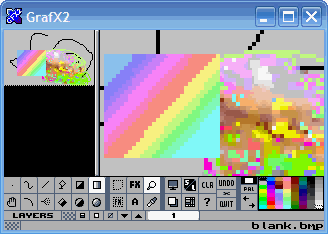Color cycling
This article needs additional citations for verification. (January 2021) |

Color cycling, also known as palette shifting, is a technique used in computer graphics in which colors are changed in order to give the impression of animation. This technique was mainly used in early computer games, as storing one image and changing its palette required less memory and processor power than storing the animation as several frames.
Examples of use[]

Animated color cycling feature as in FractInt
- The Windows 9x boot screen used color cycling to provide animation.
- The 3D maze screensaver included with earlier versions of Windows used color cycling to animate the four fractal textures available.
- The Amiga Boing Ball cycled the ball's checkerboard pattern between red and white to create the illusion of the ball rotating. The same technique was used by Sonic the Hedgehog 3 on the Sega Genesis in its bonus stages featuring a rolling checkerboard sphere.
- SimCity 2000 made extensive use of this technique: every building with animation had its animation provided by color cycling. This was used to provide effects such as blinking lights, cars moving on roads, and even four frames of animation displaying on a tiny movie screen in a drive-in theater.
- Many adventure games used color cycling to simulate moving water, lava and similar effects.
- Mickey Mania, on the Sega Genesis, used color cycling to simulate ground movement in a pseudo-3D section.[1]
External links[]
- Gallery featuring the color cycling effect through HTML 5
- Gallery featuring the color cycling effect through HTML5 with extra features
References[]
- ^ Mickey Mania's "Impossible" 3D Chase - How Was It Done? https://www.youtube.com/watch?v=nt-AxAqlrOo
Categories:
- Computer animation
- Demo effects
- Amiga
- Computer graphics stubs